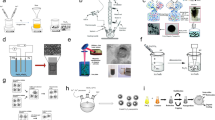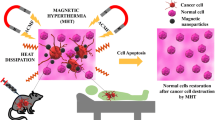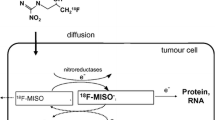Abstract
Current therapy for glioblastoma multiforme (GBM) is largely ineffective, with nearly universal tumor recurrence. The failure of current therapy is primarily due to the lack of approaches for the efficient delivery of therapeutics to diffuse tumors in the brain. In our prior study, we developed brain-penetrating nanoparticles that are capable of penetrating brain tissue and distribute over clinically relevant volumes when administered via convection-enhanced delivery (CED). We demonstrated that these particles are capable of efficient delivery of chemotherapeutics to diffuse tumors in the brain, indicating that they may serve as a groundbreaking approach for the treatment of GBM. In the original study, nanoparticles in the brain were imaged using positron emission tomography (PET). However, clinical translation of this delivery platform can be enabled by engineering a non-invasive detection modality using magnetic resonance imaging (MRI). For this purpose, we developed chemistry to incorporate superparamagnetic iron oxide (SPIO) into the brain-penetrating nanoparticles. We demonstrated that SPIO-loaded nanoparticles, which retain the same morphology as nanoparticles without SPIO, have an excellent transverse (T2) relaxivity. After CED, the distribution of nanoparticles in the brain (i.e., in the vicinity of injection site) can be detected using MRI and the long-lasting signal attenuation of SPIO-loaded brain-penetrating nanoparticles lasted over a one-month timecourse. Development of these nanoparticles is significant as, in future clinical applications, co-administration of SPIO-loaded nanoparticles will allow for intraoperative monitoring of particle distribution in the brain to ensure drug-loaded nanoparticles reach tumors as well as for monitoring the therapeutic benefit with time and to evaluate tumor relapse patterns.




Similar content being viewed by others
References
Mrugala MM, Chamberlain MC (2008) Mechanisms of disease: temozolomide and glioblastoma–look to the future. Nat Clin Pract Oncol 5:476–486. doi:10.1038/ncponc1155
Stupp R, Mason WP, van den Bent MJ, Weller M, Fisher B, Taphoorn MJ, Belanger K, Brandes AA, Marosi C, Bogdahn U, Curschmann J, Janzer RC, Ludwin SK, Gorlia T, Allgeier A, Lacombe D, Cairncross JG, Eisenhauer E, Mirimanoff RO, European Organisation for R, Treatment of Cancer Brain T, Radiotherapy G, National Cancer Institute of Canada Clinical Trials G (2005) Radiotherapy plus concomitant and adjuvant temozolomide for glioblastoma. N Engl J Med 352:987–996. doi:10.1056/NEJMoa043330
Stupp R, Hegi ME, Mason WP, van den Bent MJ, Taphoorn MJ, Janzer RC, Ludwin SK, Allgeier A, Fisher B, Belanger K, Hau P, Brandes AA, Gijtenbeek J, Marosi C, Vecht CJ, Mokhtari K, Wesseling P, Villa S, Eisenhauer E, Gorlia T, Weller M, Lacombe D, Cairncross JG, Mirimanoff RO, European Organisation for R, Treatment of Cancer Brain T, Radiation Oncology G, National Cancer Institute of Canada Clinical Trials G (2009) Effects of radiotherapy with concomitant and adjuvant temozolomide versus radiotherapy alone on survival in glioblastoma in a randomised phase III study: 5-year analysis of the EORTC-NCIC trial. Lancet Oncol 10:459–466. doi:10.1016/S1470-2045(09)70025-7
Wick W, Weller M, van den Bent M, Stupp R (2010) Bevacizumab and recurrent malignant gliomas: a European perspective. J Clin Oncol 28: e188–189; author reply e190–182 doi:10.1200/JCO.2009.26.9027
Parsons DW, Jones S, Zhang X, Lin JC, Leary RJ, Angenendt P, Mankoo P, Carter H, Siu IM, Gallia GL, Olivi A, McLendon R, Rasheed BA, Keir S, Nikolskaya T, Nikolsky Y, Busam DA, Tekleab H, Diaz LA Jr, Hartigan J, Smith DR, Strausberg RL, Marie SK, Shinjo SM, Yan H, Riggins GJ, Bigner DD, Karchin R, Papadopoulos N, Parmigiani G, Vogelstein B, Velculescu VE, Kinzler KW (2008) An integrated genomic analysis of human glioblastoma multiforme. Science 321:1807–1812. doi:10.1126/science.1164382
Balss J, Meyer J, Mueller W, Korshunov A, Hartmann C, von Deimling A (2008) Analysis of the IDH1 codon 132 mutation in brain tumors. Acta Neuropathol 116:597–602. doi:10.1007/s00401-008-0455-2
Benita Y, Kikuchi H, Smith AD, Zhang MQ, Chung DC, Xavier RJ (2009) An integrative genomics approach identifies Hypoxia Inducible Factor-1 (HIF-1)-target genes that form the core response to hypoxia. Nucleic Acids Res 37:4587–4602. doi:10.1093/nar/gkp425
Verhaak RG, Hoadley KA, Purdom E, Wang V, Qi Y, Wilkerson MD, Miller CR, Ding L, Golub T, Mesirov JP, Alexe G, Lawrence M, O’Kelly M, Tamayo P, Weir BA, Gabriel S, Winckler W, Gupta S, Jakkula L, Feiler HS, Hodgson JG, James CD, Sarkaria JN, Brennan C, Kahn A, Spellman PT, Wilson RK, Speed TP, Gray JW, Meyerson M, Getz G, Perou CM, Hayes DN, Cancer Genome Atlas Research N (2010) Integrated genomic analysis identifies clinically relevant subtypes of glioblastoma characterized by abnormalities in PDGFRA, IDH1, EGFR, and NF1. Cancer Cell 17:98–110. doi:10.1016/j.ccr.2009.12.020
Rao SK, Edwards J, Joshi AD, Siu IM, Riggins GJ (2010) A survey of glioblastoma genomic amplifications and deletions. J Neuro-Oncol 96:169–179. doi:10.1007/s11060-009-9959-4
Cerami E, Demir E, Schultz N, Taylor BS, Sander C (2010) Automated network analysis identifies core pathways in glioblastoma. PLoS ONE 5:e8918. doi:10.1371/journal.pone.0008918
Gerlinger M, Rowan AJ, Horswell S, Larkin J, Endesfelder D, Gronroos E, Martinez P, Matthews N, Stewart A, Tarpey P, Varela I, Phillimore B, Begum S, McDonald NQ, Butler A, Jones D, Raine K, Latimer C, Santos CR, Nohadani M, Eklund AC, Spencer-Dene B, Clark G, Pickering L, Stamp G, Gore M, Szallasi Z, Downward J, Futreal PA, Swanton C (2012) Intratumor heterogeneity and branched evolution revealed by multiregion sequencing. N Engl J Med 366:883–892. doi:10.1056/NEJMoa1113205
Sottoriva A, Spiteri I, Piccirillo SG, Touloumis A, Collins VP, Marioni JC, Curtis C, Watts C, Tavare S (2013) Intratumor heterogeneity in human glioblastoma reflects cancer evolutionary dynamics. Proc Nat Acad Sci USA 110:4009–4014. doi:10.1073/pnas.1219747110
Singh SK, Clarke ID, Hide T, Dirks PB (2004) Cancer stem cells in nervous system tumors. Oncogene 23:7267–7273. doi:10.1038/sj.onc.1207946
Clarke MF (2004) Neurobiology: at the root of brain cancer. Nature 432:281–282. doi:10.1038/432281a
Ohgaki H, Kleihues P (2005) Epidemiology and etiology of gliomas. Acta Neuropathol 109:93–108. doi:10.1007/s00401-005-0991-y
Jordan CT, Guzman ML, Noble M (2006) Cancer stem cells. N Engl J Med 355:1253–1261. doi:10.1056/NEJMra061808
Keith B, Simon MC (2007) Hypoxia-inducible factors, stem cells, and cancer. Cell 129:465–472. doi:10.1016/j.cell.2007.04.019
Fan X, Salford LG, Widegren B (2007) Glioma stem cells: evidence and limitation. Semi Cancer Biol 17:214–218. doi:10.1016/j.semcancer.2006.04.002
Stiles CD, Rowitch DH (2008) Glioma stem cells: a midterm exam. Neuron 58:832–846. doi:10.1016/j.neuron.2008.05.031
Soeda A, Park M, Lee D, Mintz A, Androutsellis-Theotokis A, McKay RD, Engh J, Iwama T, Kunisada T, Kassam AB, Pollack IF, Park DM (2009) Hypoxia promotes expansion of the CD133-positive glioma stem cells through activation of HIF-1alpha. Oncogene 28:3949–3959. doi:10.1038/onc.2009.252
Seidel S, Garvalov BK, Wirta V, von Stechow L, Schanzer A, Meletis K, Wolter M, Sommerlad D, Henze AT, Nister M, Reifenberger G, Lundeberg J, Frisen J, Acker T (2010) A hypoxic niche regulates glioblastoma stem cells through hypoxia inducible factor 2 alpha. Brain 133:983–995. doi:10.1093/brain/awq042
Charles NA, Holland EC, Gilbertson R, Glass R, Kettenmann H (2011) The brain tumor microenvironment. Glia 59:1169–1180. doi:10.1002/glia.21136
Soda Y, Marumoto T, Friedmann-Morvinski D, Soda M, Liu F, Michiue H, Pastorino S, Yang M, Hoffman RM, Kesari S, Verma IM (2011) Transdifferentiation of glioblastoma cells into vascular endothelial cells. Proc Nat Acad Sci U S A 108:4274–4280. doi:10.1073/pnas.1016030108
Zhou J, Patel TR, Sirianni RW, Strohbehn G, Zheng M-Q, Duong N, Schafbauer T, Huttner AJ, Huang Y, Carson RE, Zhang Y, Sullivan DJ Jr, Piepmeier JM, Saltzman WM (2013) Highly penetrative, drug-loaded nanocarriers improve treatment of glioblastoma. Proc Natl Acad Sci U S A 110:11751–11756
Thorne RG, Nicholson C (2006) In vivo diffusion analysis with quantum dots and dextrans predicts the width of brain extracellular space. Proc Natl Acad Sci U S A 103:5567–5572. doi:10.1073/pnas.0509425103
Hobbs SK, Monsky WL, Yuan F, Roberts WG, Griffith L, Torchilin VP, Jain RK (1998) Regulation of transport pathways in tumor vessels: role of tumor type and microenvironment. Proc Natl Acad Sci U S A 95:4607–4612
Bobo RH, Laske DW, Akbasak A, Morrison PF, Dedrick RL, Oldfield EH (1994) Convection-enhanced delivery of macromolecules in the brain. Proc Nat Acad Sci U S A 91:2076–2080
Sawyer AJ, Piepmeier JM, Saltzman WM (2006) New methods for direct delivery of chemotherapy for treating brain tumors. Yale J Biol Med 79:141–152
Kunwar S, Chang S, Westphal M, Vogelbaum M, Sampson J, Barnett G, Shaffrey M, Ram Z, Piepmeier J, Prados M, Croteau D, Pedain C, Leland P, Husain SR, Joshi BH, Puri RK, Group PS (2010) Phase III randomized trial of CED of IL13-PE38QQR vs Gliadel wafers for recurrent glioblastoma. Neuro-oncology 12:871–881. doi:10.1093/neuonc/nop054
Sampson JH, Archer G, Pedain C, Wembacher-Schroder E, Westphal M, Kunwar S, Vogelbaum MA, Coan A, Herndon JE, Raghavan R, Brady ML, Reardon DA, Friedman AH, Friedman HS, Rodriguez-Ponce MI, Chang SM, Mittermeyer S, Croteau D, Puri RK, Investigators PT (2010) Poor drug distribution as a possible explanation for the results of the PRECISE trial. J Neurosur 113:301–309. doi:10.3171/2009.11.JNS091052
Rahmim A, Zaidi H (2008) PET versus SPECT: strengths, limitations and challenges. Nuclear Med Commun 29:193–207. doi:10.1097/MNM.0b013e3282f3a515
Ratzinger G, Agrawal P, Korner W, Lonkai J, Sanders HM, Terreno E, Wirth M, Strijkers GJ, Nicolay K, Gabor F (2010) Surface modification of PLGA nanospheres with Gd-DTPA and Gd-DOTA for high-relaxivity MRI contrast agents. Biomaterials 31:8716–8723. doi:10.1016/j.biomaterials.2010.07.095
Hadjipanayis CG, Machaidze R, Kaluzova M, Wang L, Schuette AJ, Chen H, Wu X, Mao H (2010) EGFRvIII antibody-conjugated iron oxide nanoparticles for magnetic resonance imaging-guided convection-enhanced delivery and targeted therapy of glioblastoma. Cancer Res 70:6303–6312. doi:10.1158/0008-5472.CAN-10-1022
Muldoon LL, Sandor M, Pinkston KE, Neuwelt EA (2005) Imaging, distribution, and toxicity of superparamagnetic iron oxide magnetic resonance nanoparticles in the rat brain and intracerebral tumor. Neurosurgery 57:785–796 discussion 785–796
Platt S, Nduom E, Kent M, Freeman C, Machaidze R, Kaluzova M, Wang L, Mao H, Hadjipanayis CG (2012) Canine model of convection-enhanced delivery of cetuximab-conjugated iron-oxide nanoparticles monitored with magnetic resonance imaging. Clin Neurosur 59:107–113. doi:10.1227/NEU.0b013e31826989ef
Jung CW, Jacobs P (1995) Physical and chemical properties of superparamagnetic iron oxide MR contrast agents: ferumoxides, ferumoxtran, ferumoxsil. Magn Reson Imaging 13:661–674
Prince MR, Zhang HL, Chabra SG, Jacobs P, Wang Y (2003) A pilot investigation of new superparamagnetic iron oxide (ferumoxytol) as a contrast agent for cardiovascular MRI. J X-ray Sci Technol 11:231–240
Nguyen BC, Stanford W, Thompson BH, Rossi NP, Kernstine KH, Kern JA, Robinson RA, Amorosa JK, Mammone JF, Outwater EK (1999) Multicenter clinical trial of ultrasmall superparamagnetic iron oxide in the evaluation of mediastinal lymph nodes in patients with primary lung carcinoma. J Magn Reson Imaging 10:468–473
Ragheb RR, Kim D, Bandyopadhyay A, Chahboune H, Bulutoglu B, Ezaldein H, Criscione JM, Fahmy TM (2013) Induced clustered nanoconfinement of superparamagnetic iron oxide in biodegradable nanoparticles enhances transverse relaxivity for targeted theranostics. Magn Reson Med 70:1748–1760. doi:10.1002/mrm.24622
Neeves KB, Lo CT, Foley CP, Saltzman WM, Olbricht WL (2006) Fabrication and characterization of microfluidic probes for convection enhanced drug delivery. J Control Release 111:252–262. doi:10.1016/j.jconrel.2005.11.018
Weinstein JS, Varallyay CG, Dosa E, Gahramanov S, Hamilton B, Rooney WD, Muldoon LL, Neuwelt EA (2010) Superparamagnetic iron oxide nanoparticles: diagnostic magnetic resonance imaging and potential therapeutic applications in neurooncology and central nervous system inflammatory pathologies, a review. J Cerebral Blood Flow Metabol 30:15–35. doi:10.1038/jcbfm.2009.192
Saleh A, Schroeter M, Ringelstein A, Hartung HP, Siebler M, Modder U, Jander S (2007) Iron oxide particle-enhanced MRI suggests variability of brain inflammation at early stages after ischemic stroke. Stroke 38:2733–2737. doi:10.1161/strokeaha.107.481788
Dousset V, Delalande C, Ballarino L, Quesson B, Seilhan D, Coussemacq M, Thiaudiere E, Brochet B, Canioni P, Caille JM (1999) In vivo macrophage activity imaging in the central nervous system detected by magnetic resonance. Magn Reson Med 41:329–333
Neuwelt EA, Varallyay CG, Manninger S, Solymosi D, Haluska M, Hunt MA, Nesbit G, Stevens A, Jerosch-Herold M, Jacobs PM, Hoffman JM (2007) The potential of ferumoxytol nanoparticle magnetic resonance imaging, perfusion, and angiography in central nervous system malignancy: a pilot study. Neurosurgery 60:601–611. doi:10.1227/01.NEU.0000255350.71700.37 discussion 611–602
Acknowledgments
This work was supported by a T-TARE award from the Yale Cancer Center (WMS & JP), grants from the US National Institutes of Health to WMS (CA149128) and FH (CA-140102, EB-011968, NS-052519),VABC Foundation (WMS, JP & JZ), Yale Center for Clinical Investigation (CTSA UL1 TR000142, JZ), American Cancer Society (IRG 58-012-55, JZ), and Matthew Larson Foundation (JZ).
Conflict of interest
The authors report no conflicts of interest. The authors alone are responsible for the content and writing of the paper.
Author information
Authors and Affiliations
Corresponding author
Additional information
G. Strohbehn and D. Coman have contributed equally to this work.
Electronic supplementary material
Below is the link to the electronic supplementary material.
Rights and permissions
About this article
Cite this article
Strohbehn, G., Coman, D., Han, L. et al. Imaging the delivery of brain-penetrating PLGA nanoparticles in the brain using magnetic resonance. J Neurooncol 121, 441–449 (2015). https://doi.org/10.1007/s11060-014-1658-0
Received:
Accepted:
Published:
Issue Date:
DOI: https://doi.org/10.1007/s11060-014-1658-0




